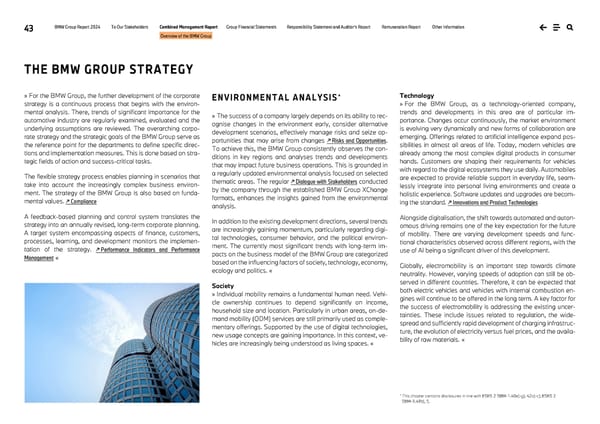43 BMW Group Report 2024 To Our Stakeholders Combined Management Report Group Financial Statements Responsibility Statement and Auditor’s Report Remuneration Report Other Information Overview of the BMW Group THE BMW GROUP STRATEGY » For the BMW Group, the further development of the corporate strategy is a continuous process that begins with the environ- mental analysis. There, trends of significant importance for the automotive industry are regularly examined, evaluated and the underlying assumptions are reviewed. The overarching corpo- rate strategy and the strategic goals of the BMW Group serve as the reference point for the departments to define specific direc- tions and implementation measures. This is done based on stra- tegic fields of action and success-critical tasks. The flexible strategy process enables planning in scenarios that take into account the increasingly complex business environ- ment. The strategy of the BMW Group is also based on funda- mental values. ↗ Compliance A feedback-based planning and control system translates the strategy into an annually revised, long-term corporate planning. A target system encompassing aspects of finance, customers, processes, learning, and development monitors the implemen- tation of the strategy. ↗ Performance Indicators and Performance Management « ENVIRONMENTAL ANALYSIS * » The success of a company largely depends on its ability to rec- ognise changes in the environment early, consider alternative development scenarios, effectively manage risks and seize op- portunities that may arise from changes ↗ Risks and Opportunities. To achieve this, the BMW Group consistently observes the con- ditions in key regions and analyses trends and developments that may impact future business operations. This is grounded in a regularly updated environmental analysis focused on selected thematic areas. The regular ↗ Dialogue with Stakeholders conducted by the company through the established BMW Group XChange formats, enhances the insights gained from the environmental analysis. In addition to the existing development directions, several trends are increasingly gaining momentum, particularly regarding digi- tal technologies, consumer behavior, and the political environ- ment. The currently most significant trends with long-term im- pacts on the business model of the BMW Group are categorized based on the influencing factors of society, technology, economy, ecology and politics. « Society » Individual mobility remains a fundamental human need. Vehi- cle ownership continues to depend significantly on income, household size and location. Particularly in urban areas, on-de- mand mobility (ODM) services are still primarily used as comple- mentary offerings. Supported by the use of digital technologies, new usage concepts are gaining importance. In this context, ve- hicles are increasingly being understood as living spaces. « Technology » For the BMW Group, as a technology-oriented company, trends and developments in this area are of particular im- portance. Changes occur continuously, the market environment is evolving very dynamically and new forms of collaboration are emerging. Offerings related to artificial intelligence expand pos- sibilities in almost all areas of life. Today, modern vehicles are already among the most complex digital products in consumer hands. Customers are shaping their requirements for vehicles with regard to the digital ecosystems they use daily. Automobiles are expected to provide reliable support in everyday life, seam- lessly integrate into personal living environments and create a holistic experience. Software updates and upgrades are becom- ing the standard. ↗ Innovations and Product Technologies Alongside digitalisation, the shift towards automated and auton- omous driving remains one of the key expectation for the future of mobility. There are varying development speeds and func- tional characteristics observed across different regions, with the use of AI being a significant driver of this development. Globally, electromobility is an important step towards climate neutrality. However, varying speeds of adoption can still be ob- served in different countries. Therefore, it can be expected that both electric vehicles and vehicles with internal combustion en- gines will continue to be offered in the long term. A key factor for the success of electromobility is addressing the existing uncer- tainties. These include issues related to regulation, the wide- spread and sufficiently rapid development of charging infrastruc- ture, the evolution of electricity versus fuel prices, and the availa- bility of raw materials. « * This chapter contains disclosures in line with ESRS 2 SBM-1.40e)-g); 42a)-c); ESRS 2 SBM-3.48b), f).
 BMW Group Report 2024 Page 42 Page 44
BMW Group Report 2024 Page 42 Page 44